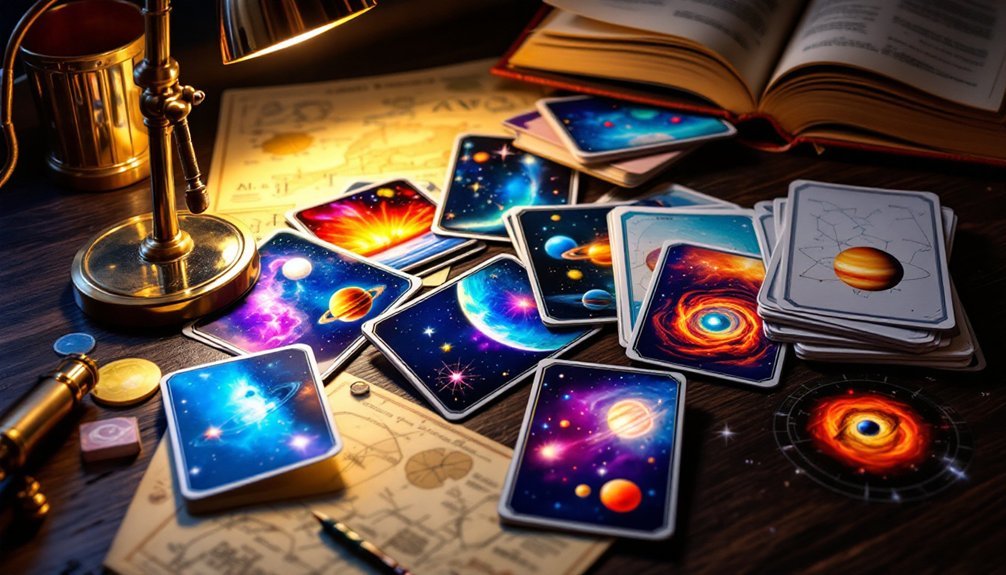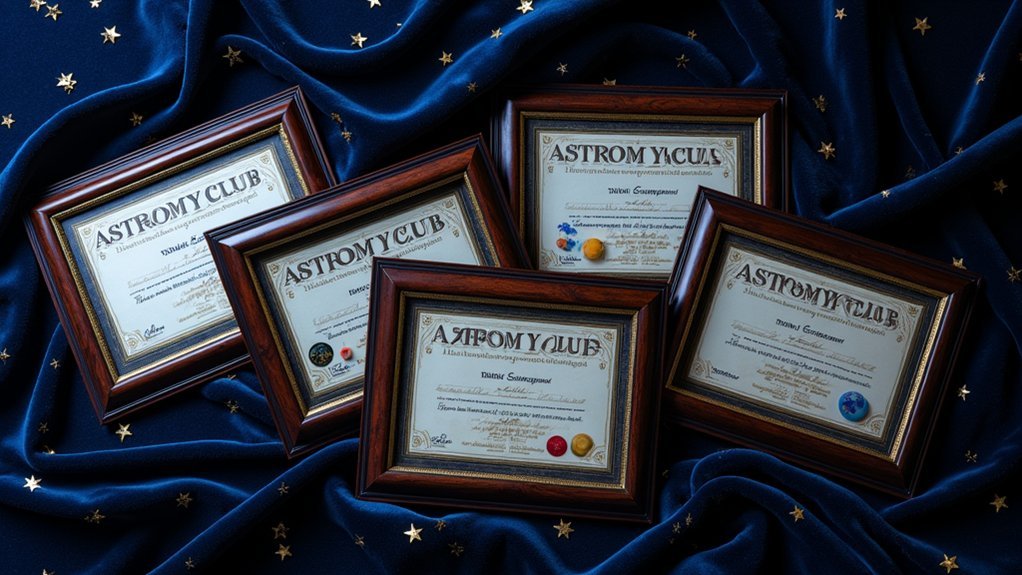You've probably gazed at the stars and wondered about the mysteries they hold, but mastering astronomy can feel overwhelming. Whether you're a beginner or an enthusiast looking to expand your knowledge, the right flashcards can transform complex cosmic concepts into bite-sized, memorable lessons. From detailed constellation guides to extensive space object collections, these seven carefully selected astronomy flashcards will help you navigate the universe with confidence and enjoyment.
75 Space Flash Cards – STEM Learning Resource for Astronomy
If you're seeking a thorough astronomy learning tool, these 75 space flash cards from Briston offer an ideal STEM resource for students ages 15 and up. The cards feature vivid astronomical images paired with five informative facts on each reverse side, covering everything from planets to galaxies.
Built with durability in mind, these flashcards use 300gsm cardstock with glossy lamination that resists water and scratches. At 3.55 x 2.05 inches, they're perfectly portable for on-the-go learning. With a strong 4.5-star rating from 47 users, they've proven effective for both classroom and homeschool settings. You'll find them especially valuable for fostering space science interest and supporting curriculum-based learning.
Best For: High school and college students interested in astronomy, as well as homeschool families seeking a durable STEM learning resource that combines visual engagement with factual content.
Pros:
- High-quality construction with 300gsm cardstock and water-resistant lamination
- Comprehensive content with 5 detailed facts per card and vivid astronomical images
- Portable size and durable design make them ideal for both classroom and travel use
Cons:
- Limited coverage with only 75 cards when compared to the vast scope of astronomy
- May be too advanced for younger children under 10 without significant guidance
- Some users reported wanting larger card sizes for better image viewing
CARDDIA Astronomical Constellations Educational Flashcards
Aspiring astronomers and educators will find exceptional value in CARDDIA's extensive constellation flashcard set. You'll get 88 durable cards covering every northern and southern hemisphere constellation, complete with clear star diagrams on the front and essential details on the back.
Each card features the constellation's name, abbreviation, star names, and family classification. Though some users note the text is small, the water-resistant, glossy cards are perfectly sized for hands-on learning. At 2.72 x 1.38 x 3.58 inches, they're portable enough for field use. Whether you're teaching in a classroom or studying independently, these 4.5-star-rated flashcards will help you master celestial navigation.
Best For: Astronomy students, educators, and enthusiasts seeking a comprehensive learning tool for mastering constellation identification and celestial navigation.
Pros:
- Complete coverage of all 88 constellations from both hemispheres with detailed star diagrams
- Durable, water-resistant construction ideal for outdoor use and frequent handling
- Well-organized information including constellation names, abbreviations, star names, and family classifications
Cons:
- Small text size on card backs may be difficult to read for some users
- Cards may initially stick together and require careful separation
- Relatively high price point compared to basic flashcards (#239,429 in Toys & Games ranking suggests limited accessibility)
75 Space Flash Cards for STEM Learning & Astronomy
Passionate space enthusiasts and STEM students will discover a thorough learning tool in these 75 expertly crafted flash cards. Manufactured by Michigan's family-owned Briston company, each card features stunning astronomical imagery on 300gsm cardstock with five detailed facts on the reverse.
You'll find these durable 3.55 x 2.05-inch cards perfect for various learning levels, from elementary to high school. The laminated, water-resistant design guarantees they'll withstand frequent use while exploring planets, stars, galaxies, and satellites. While primarily recommended for ages 15+, younger space enthusiasts can benefit with parental guidance. With a 4.5-star rating, they're an excellent choice for both classroom and homeschool astronomy education.
Best For: Astronomy enthusiasts, STEM students, and educators seeking durable, comprehensive flash cards for space science education at various learning levels.
Pros:
- High-quality construction with 300gsm cardstock and water-resistant lamination for long-lasting use
- Comprehensive educational content featuring vivid images and five detailed facts per card
- Versatile learning tool suitable for multiple age groups and educational settings
Cons:
- Limited collection size of only 75 cards may not cover all desired astronomical topics
- Card size (3.55 x 2.05 inches) may be too small for some users' preferences
- Recommended age of 15+ may discourage younger interested learners without parental guidance
Briston 88 Constellation Astronomy Flash Cards for STEM Learning
Students and educators seeking thorough constellation knowledge will find the Briston 88 Constellation Astronomy Flash Cards an invaluable STEM learning tool. These durable 300GSM cards feature high-resolution photos and detailed information on all 88 constellations.
You'll appreciate the water-resistant, glossy lamination and curved edges that make handling easy. At 3.5L x 2.5W inches, they'll fit perfectly in your pocket or backpack. Whether you're stargazing with a telescope or studying indoors, these cards deliver extensive celestial information with vibrant visuals and clear text. With a 4.5-star rating from users, they're ideal for ages 15 and up, serving both beginners and advanced astronomy enthusiasts.
Best For: High school students, educators, and astronomy enthusiasts seeking a comprehensive and portable learning tool for studying constellations and celestial bodies.
Pros:
- Durable construction with water-resistant lamination and curved edges for frequent handling
- Compact and portable size makes them perfect for both classroom and field use
- High-quality images and detailed information covering all 88 constellations
Cons:
- Size may be too small for some users who prefer larger, more detailed images
- May be too advanced for younger children under 15
- Packaging could be more sturdy for long-term storage and protection
CARDDIA Astronomical Objects STEM Educational Flashcards
Space enthusiasts seeking extensive astronomical knowledge will find CARDDIA's 52-card educational set an invaluable learning tool. Each card features NASA's high-resolution photos on one side, while the other contains essential details like names, symbols, and structural descriptions of various celestial objects.
You'll explore planets, minor planets, satellites, galaxies, clusters, and nebulae through these durable, glossy-coated cards. They're water-resistant, portable, and come with a helpful Universe Infographic. While they're particularly suited for 7th-grade science, anyone interested in astronomy will benefit from their thorough content. The lifetime warranty and stellar customer reviews confirm their educational value and quality construction.
Best For: Middle school students, astronomy enthusiasts, and educators seeking a comprehensive, portable learning tool for studying celestial objects.
Pros:
- High-quality NASA images and detailed educational content on each card
- Durable construction with water-resistant, glossy coating
- Includes Universe Infographic and covers wide range of astronomical objects
Cons:
- Some cards contain minor spelling errors
- Higher price point compared to similar products
- Limited to 52 cards, which may not cover all desired astronomical objects
Astronomy: A Self-Teaching Guide, Eighth Edition
Amateur astronomers seeking extensive knowledge will find "Astronomy: A Self-Teaching Guide, Eighth Edition" both challenging and rewarding. The book explores deep into scientific concepts with helpful tables and graphics, though you'll need solid mathematical understanding to fully grasp topics like telescopes and light waves.
While it's marketed as a self-teaching guide, you might struggle if you're a complete beginner. If you're just starting out, consider "Night Watch" or "Astronomy for Dummies" instead. However, if you're ready to shift from basic stargazing to understanding complex astronomical concepts, this thorough resource will fuel your passion for exploring the universe.
Best For: Intermediate astronomy enthusiasts who have basic knowledge and are ready to dive deeper into the scientific and mathematical aspects of astronomy.
Pros:
- Comprehensive coverage of advanced astronomical concepts with helpful tables and graphics
- Thorough exploration of scientific principles behind telescopes, light waves, and celestial phenomena
- Excellent resource for transitioning from basic stargazing to serious astronomical study
Cons:
- Too complex for complete beginners despite "self-teaching" label
- Requires significant mathematical background for full comprehension
- May be overwhelming for those seeking purely observational astronomy guidance
CARDDIA Astronomical Constellations Educational Flashcards
For astronomy enthusiasts seeking an extensive guide to the night sky, CARDDIA's educational flashcards offer a complete set of all 88 constellations from both hemispheres. Each card displays a clear constellation diagram with star magnitudes on the front, while the back features essential details like the constellation's name, abbreviation, star names, and family.
You'll find these pocket-sized cards are built to last, with water- and tear-resistant lamination that's perfect for outdoor stargazing. While the 4.5-star rated set has earned praise for its educational value and durability, some users note the back text runs small. They're ideal for seasonal learning and make a practical gift for students, teachers, or anyone passionate about exploring the cosmos.
Best For: Amateur astronomers, students, and educators seeking a comprehensive, portable reference guide to all 88 constellations in the night sky.
Pros:
- Complete coverage of all constellations with clear diagrams and detailed information on both sides
- Durable, water-resistant construction makes them suitable for outdoor use
- Portable, standard playing card size that's easy to carry and handle
Cons:
- Small text on card backs can be difficult to read
- Cards may initially stick together and need separation
- Higher price point compared to basic flashcards (#239,429 in Toys & Games suggests limited sales volume)
Factors to Consider When Choosing Astronomy Learning Flashcards
When selecting astronomy flashcards for your learning journey, you'll need to evaluate several key factors that impact their effectiveness. You should match the content level to your age group or knowledge base, check the cards' physical durability, and guarantee thorough topic coverage that aligns with your learning goals. The cards' visual quality and size must also support easy reading and handling while maintaining clear astronomical imagery and essential information.
Age-Appropriate Content Level
Selecting age-appropriate astronomy flashcards plays an essential role in maximizing learning effectiveness. You'll want to match the content level with the user's educational background and comprehension abilities. While younger children benefit from cards with simple explanations and engaging visuals, older students and adults might prefer more advanced concepts and detailed scientific data.
Check the recommended age range on the flashcard sets, as they're specifically designed for different learning stages. High school-level cards typically contain more complex information compared to elementary versions. Don't forget to read customer reviews, as they often provide valuable insights into how well specific sets work for different age groups. This feedback can help you choose flashcards that'll provide the right balance of challenge and understanding for your learning journey.
Physical Card Durability
The physical durability of astronomy flashcards directly impacts their long-term value and effectiveness. When selecting your cards, look for those made from thick cardstock or sturdy paper that can handle frequent use without deteriorating.
You'll want cards with a glossy laminated finish, as this protective coating helps guard against water damage, dust accumulation, and unsightly scratches. The cards should also be tear-resistant to withstand active learning sessions and outdoor stargazing activities. Consider the weight of your flashcards too – lighter ones are easier to carry and handle during extended study periods.
Before making your purchase, check durability ratings and user reviews to verify you're getting cards that'll last. This feedback can give you valuable insights into how well the flashcards perform in real-world educational settings.
Information Depth Coverage
Information depth stands as an essential factor in choosing effective astronomy flashcards for your studies. You'll want to guarantee your flashcards cover an extensive range of topics, from basic planetary facts to complex galactic concepts. Look for sets that provide detailed classifications, physical characteristics, and key scientific data for each astronomical object.
Your chosen flashcards should align with your current learning level while offering room for advancement. Check that they include important details like stellar classifications, orbital patterns, and astronomical phenomena. The best sets combine thorough scientific information with clear explanations that you can easily grasp and retain. While evaluating options, verify that the content matches relevant astronomy curricula and includes up-to-date scientific findings to support your educational goals.
Visual Design Quality
Beyond thorough content, visual design quality plays a major role in the effectiveness of astronomy flashcards. You'll want to look for cards featuring high-resolution images that make celestial objects pop and enhance your ability to memorize them. A glossy, laminated finish isn't just about looks—it'll protect your cards from water damage, dust, and scratches during frequent use.
The best cards combine vivid visuals with clear, concise text that's easy to read at a glance. They should be sized like standard playing cards for convenient handling and storage. Look for cards that incorporate helpful diagrams or infographics, as these visual aids will help you better understand relationships between astronomical concepts. These design elements work together to create an engaging and effective learning tool.
Card Size Considerations
Selecting appropriate card dimensions is essential when choosing astronomy flashcards for effective learning. You'll find that standard 2.5 x 3.5-inch cards offer a familiar size that's easy to handle and store in common flashcard holders or boxes. However, if you're studying detailed celestial objects or complex astronomical diagrams, you might prefer larger 3.5 x 2.5-inch cards that provide extra space for intricate visuals and explanatory text.
For astronomy students who study on-the-go, compact 3.55 x 2.05-inch cards offer excellent portability without sacrificing content quality. Whatever size you choose, make sure the cards are printed on durable cardstock (around 300gsm) to withstand frequent use. Your age or learning style should guide your choice – younger learners often benefit from larger cards with bold visuals, while older students typically prefer standard sizes.
Educational Curriculum Alignment
The right alignment with educational standards and curriculum requirements plays a key role in maximizing the value of astronomy flashcards. You'll want to choose sets that match your specific grade level or learning objectives while covering thorough topics from the solar system to constellations.
Look for flashcards that incorporate both factual content and engaging visuals, as they'll help you better grasp complex astronomical concepts. You should also consider sets that offer different difficulty levels, allowing you to progress from basic to advanced understanding at your own pace. If you're homeschooling or working with study groups, select flashcards that facilitate collaborative learning and discussion. This adaptability guarantees you're meeting educational benchmarks while making the study of astronomy both effective and engaging.
Portability and Storage
Physical attributes of astronomy flashcards can make or break their practicality for daily use. When choosing your set, opt for cards that match standard playing card dimensions, as they'll fit comfortably in your hands and pockets. You'll want to guarantee they're easy to carry to stargazing sessions or study groups.
Look for cards made with water-resistant materials and thicker cardstock that won't bend or tear easily. Rounded corners are a smart feature that prevents snagging and extends the life of your cards through repeated use. Consider how you'll store them – they should slip easily into your backpack, pencil case, or desk drawer without taking up too much space. These practical features will help you maintain and access your flashcards whenever you need them.
Image Resolution Standards
While browsing astronomy flashcards, you'll want to prioritize sets with high-resolution images of at least 300 DPI to guarantee clear, sharp visuals. High-quality images allow you to see intricate details of celestial objects, making it easier to identify and remember key astronomical features.
You'll notice that low-resolution flashcards often appear pixelated or blurry when you try to examine specific details, which can frustrate your learning experience and make memorization more difficult. Since astronomy heavily relies on visual learning, it's essential to choose flashcards that accurately represent the colors and details of space objects. When you're evaluating different flashcard sets, take a moment to check the image quality – it's a reliable indicator of the educational value you'll receive from your study materials.
Frequently Asked Questions
How Long Should I Study Astronomy Flashcards Each Day for Optimal Learning?
You'll learn best by studying astronomy flashcards for 20-30 minutes daily, with breaks every 10 minutes. Don't cram – shorter, consistent sessions help you retain information better than long marathon sessions.
Can Astronomy Flashcards Help Prepare for College-Level Astronomy Courses?
Yes, you'll find astronomy flashcards incredibly helpful for college courses. They'll strengthen your fundamental concepts, key terminology, and celestial object recognition. Regular practice will give you a solid foundation for advanced coursework.
What Age Group Are Most Astronomy Flashcards Suitable For?
You'll find astronomy flashcards work well for ages 10 and up. While elementary sets suit younger learners, most flashcards are designed for middle school through college students who're studying basic astronomical concepts.
Are Digital Astronomy Flashcards as Effective as Physical Ones?
You'll find both digital and physical flashcards can be equally effective. Digital ones offer convenience and interactive features, while physical cards provide tactile learning benefits and don't require screens or batteries.
How Often Should Astronomy Flashcards Be Updated With New Astronomical Discoveries?
You'll want to update your astronomy flashcards every 6-12 months to include major discoveries. However, don't feel pressured to add every minor finding – focus on breakthrough discoveries that change our understanding of space.
In Summary
You'll find that astronomy flashcards are invaluable tools for exploring the cosmos, whether you're a beginner or an advanced learner. They're portable, durable, and perfect for both individual study and group learning. Don't forget to reflect on your skill level, card quality, and specific astronomical interests when making your choice. With these stellar educational resources, you're well-equipped to commence your cosmic journey.





Leave a Reply